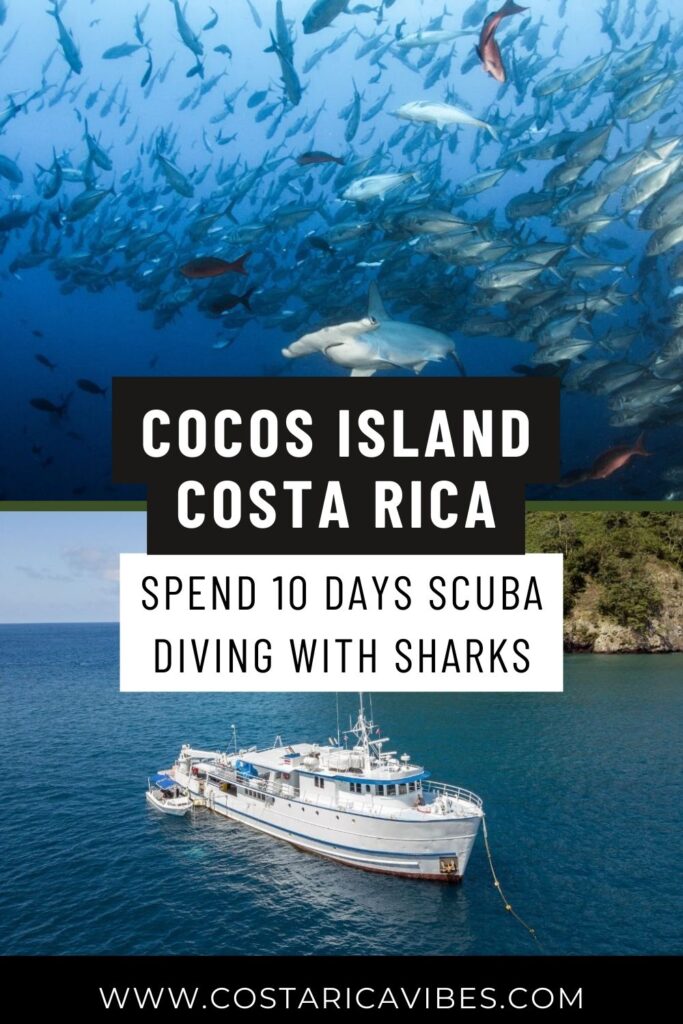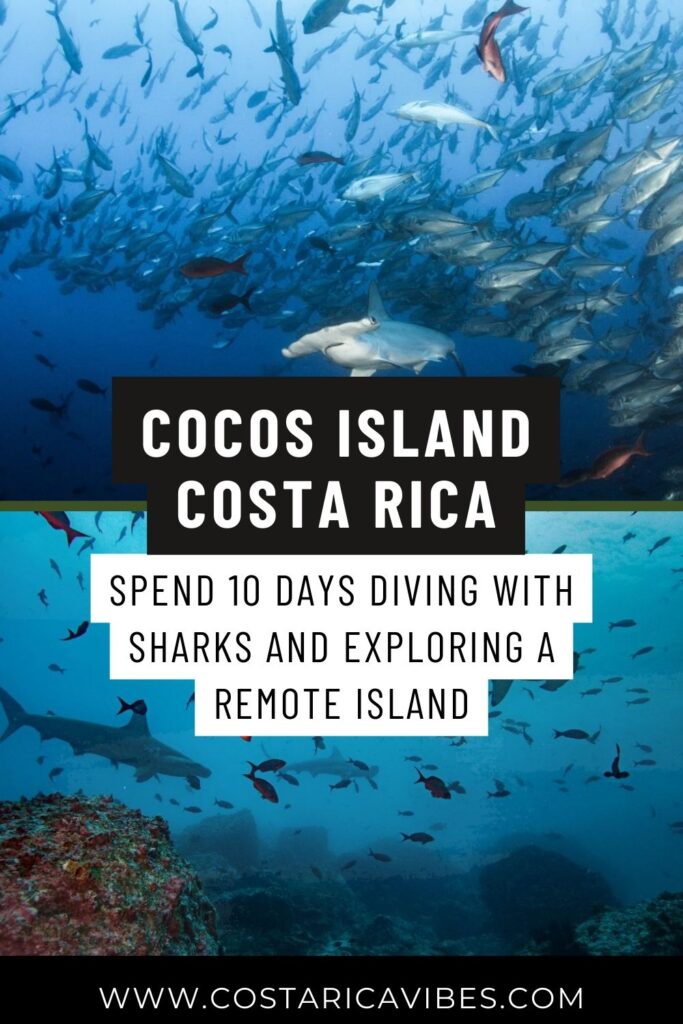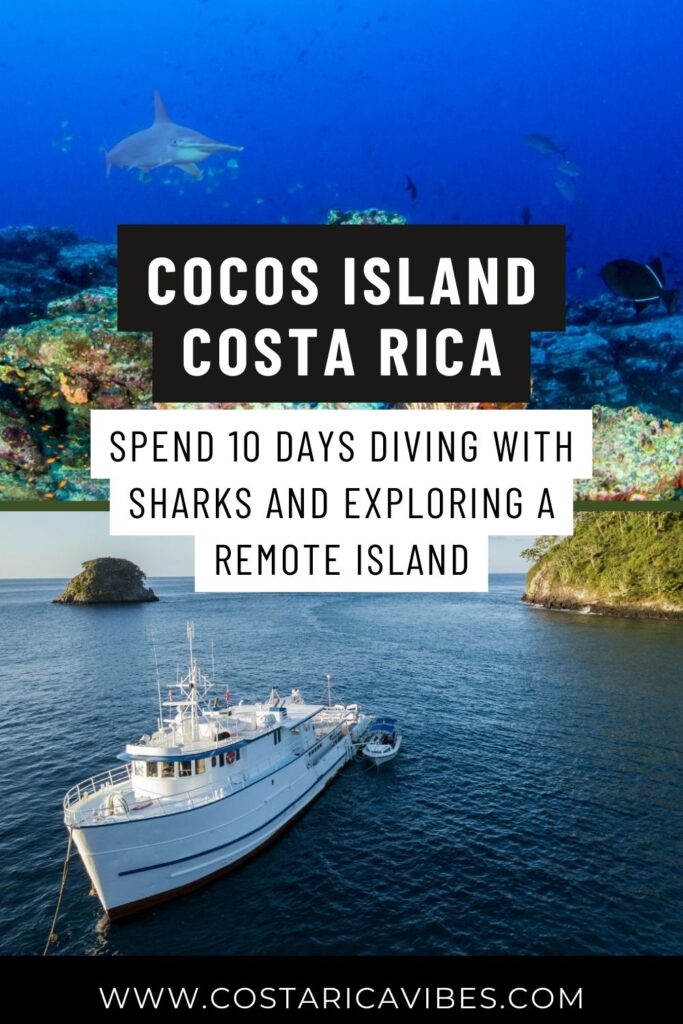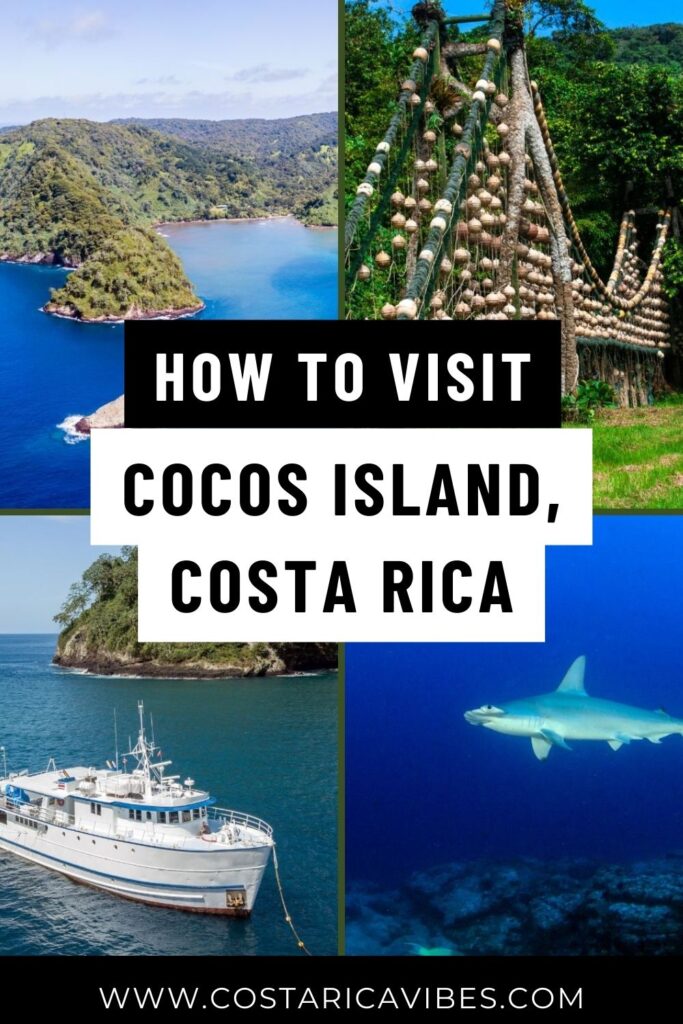Cocos Island National Park in Costa Rica: Guide for Divers
Disclaimer: This article may contain affiliate links. Clicking on them may earn Costa Rica Vibes a commission, at no extra cost to you. Thank you for your support!
Cocos Island, Costa Rica is a remote island destination on the Pacific Ocean. This is a protected area and part of the Costa Rica national park system. The island is located 300 miles off of mainland Costa Rica and the only way to visit is with a multi-day liveaboard scuba diving tour.
The real draw to this remote destination is the abundance of sharks and other marine life that live in the waters surrounding Cocos Island National Park. If you are passionate in scuba diving, this may be the perfect Costa Rica vacation option for you.
Are you ready to plan your adventure?
Read on for all the details on the best tours, the fascinating history of the island that involves buried treasure, and info about the marine life you might see on your multi-day live-aboard experience.
Just Want to Book Your Trip?
Here are the three best Cocos Island live-aboard tour options
The Cocos Island Diving Experience
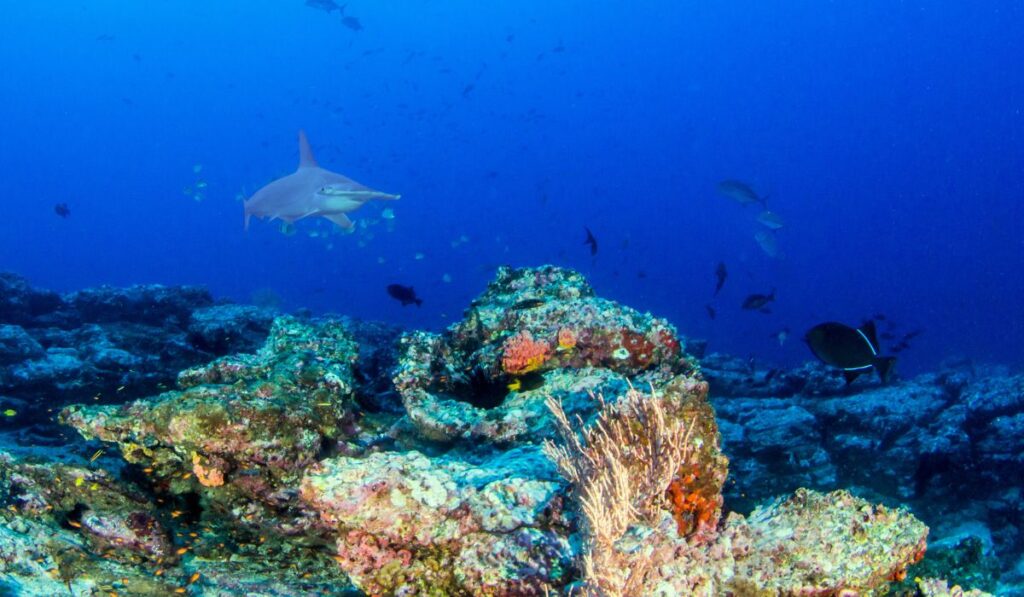
The Cocos Island diving experience starts by boarding a comfortable diving yacht in the city of Puntarenas on the Pacific coast of Costa Rica.
From here, your boat ride out to the island will take approximately 36 hours. It is definitely a very remote location!
You will then spend the next several days visiting diving sites around the island to explore coral reefs and marine life. All meals and sleeping will take place on the comfortable boat.
You will also get the chance to explore Coco’s Island National Park by land as well.
Typically, you will have the chance to dive at 3 different sites per day if you choose.
Marine Life at Cocos Island
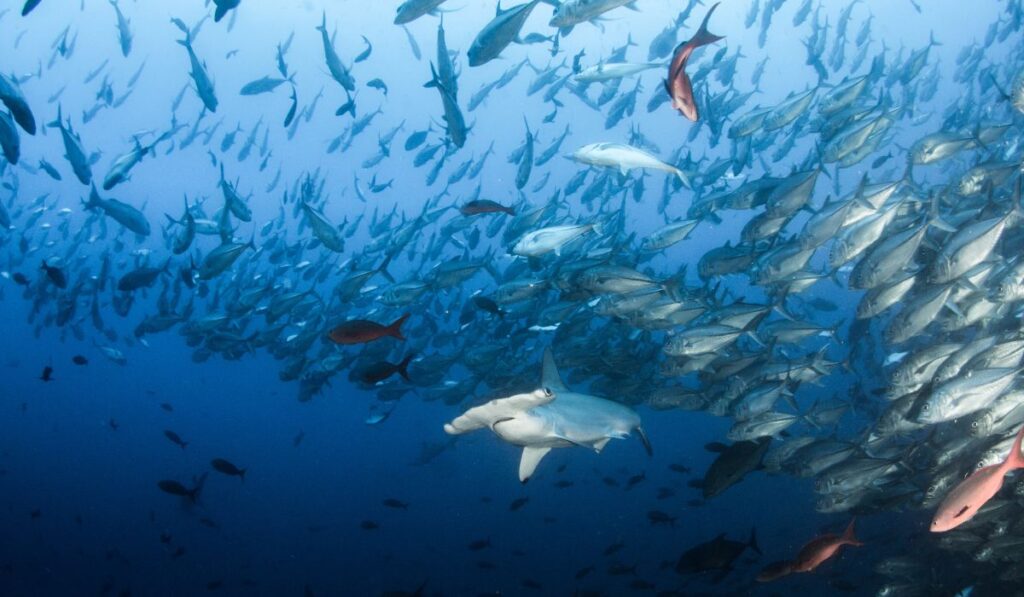
In the waters surrounding Cocos Island, you may see a variety of marine species including:
- Multiple species of sharks including scalloped hammerhead sharks, white tip reef sharks, tiger sharks, whale sharks
- sailfish
- yellowfin tuna
- giant manta rays,
- various species of sea turtles including hawksbill turtles, green turtles, olive ridley turtles
- humpback whales,
- orca whales
- bottlenose dolphins
- sea lions
- Over 300 species of fish
- 30 species of coral
- Over 60 species of crustaceans
- 600 species of mollusks.
Cocos Island Diving Sites
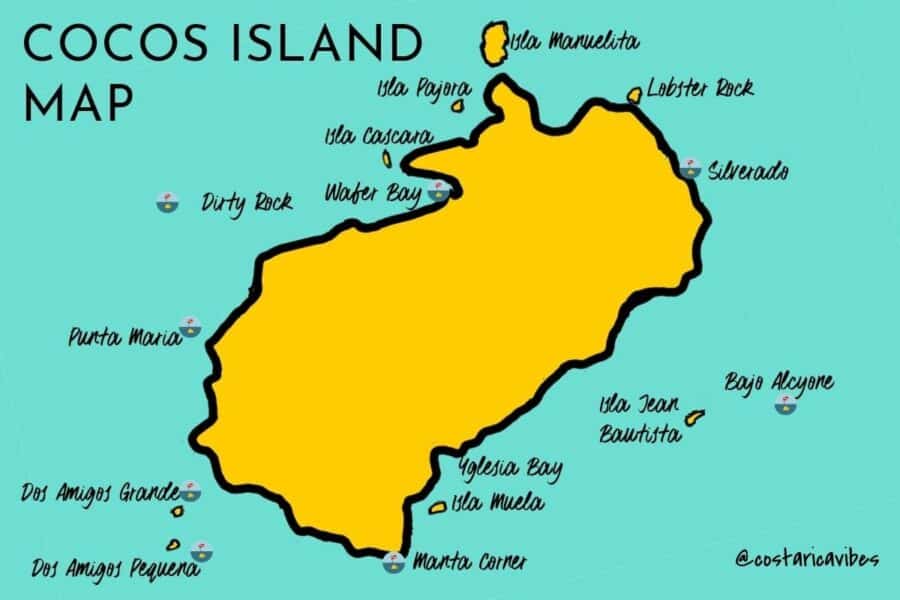
There are several dive sites that you will visit during your trip. Here are the main marine area highlights.
Bajo Alcyone
This is a great spot to see hammerhead sharks.
The seamount top is about an 82ft (25m) descent. From here, you can find a crevice to hang out and watch the hammerheads come into view in swarms. You will likely see hundreds of them. In this area, you might also see silky sharks and whale sharks.
The reef isn’t overly impressive, but there is some sea life with octopi and manta rays.
Dirty Rock
This is considered the most popular diving spot in the area due to the volume of hammerheads and the large amount of fish that gather here. You may see tuna, blacktip sharks, snapper, bigeye jacks, whale sharks, and more!
The area is made up of volcanic rock outcrops that are divided by a seed channel.
Dos Amigos Grande
Here there is an impressive underwater arch. This can be accessed at 82ft (25meter). Here you can see hammerheads, reef sharks, eagle rays, jacks, snapper, etc.
Occasionally, tiger sharks have also been known to show up in this area.
Dos Amigos Pequeña
This small island is a nice spot to swim around and see sharks, urchins, snappers, and starfish. This is an area of great visibility.
Manuelita Deep
There are numerous ledges in this area where white tip reef sharks often hang out. Just note that this area can have strong currents.
This is one of the more popular diving sites and is sometimes visited more than once on liveaboards.
Manuelita Garden
Manuelita Garden is a coral garden located atop a submerged mountain. This is one of the only coral reef dives near Cocos Island, and it is beautiful!
Visiting the Island’s Mainland
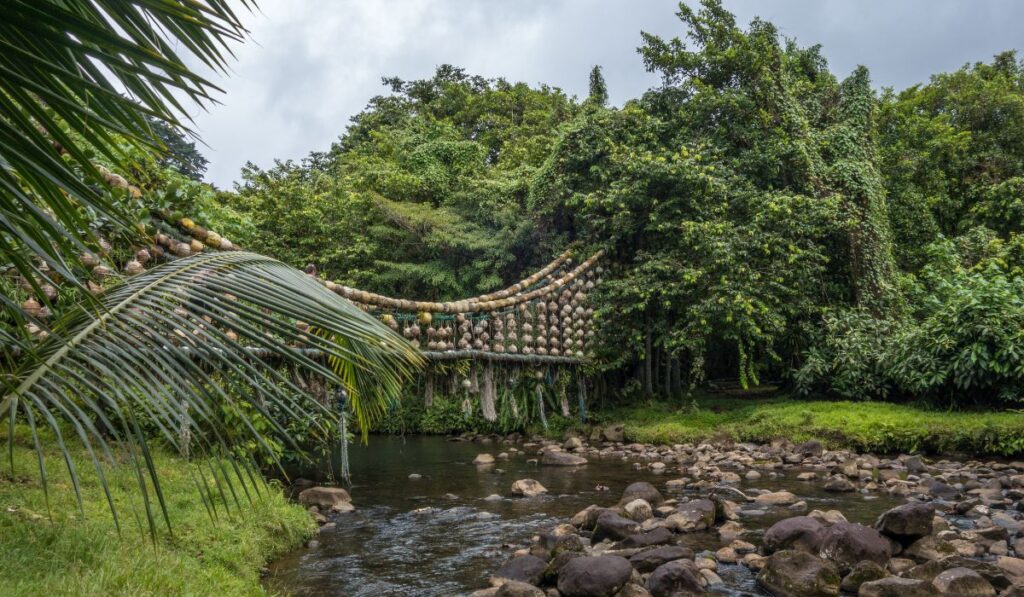
During your several days of diving at the Isla del Coco National Park you will have a few opportunities to walk with a park ranger on the island. There is a waterfall that you could previously walk to, but I read that it is now closed to visitors.
Along the way, you may see wild boars, goats, white-tailed deer, two species of rats, and house cats, over 90 species of birds including red-footed boobies, brown boobies, and Cocos finch and various species of insects.
Keep in mind that the government of Costa Rica has made this island into a national park. The only people who live out here are the national park rangers. The only people allowed to step foot on the land are people visiting on liveaboard diving tours.
History of Cocos Island
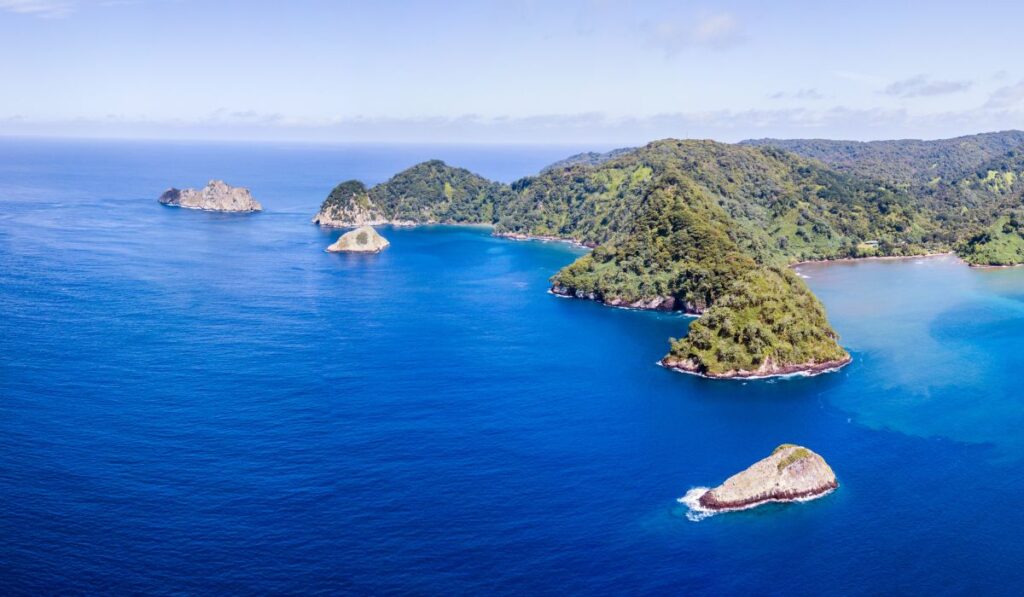
I’ve got to admit, the history of Cocos Island is one of my favorite histories in Costa Rica. It is so fascinating and it involves billions of dollars in buried treasure!
Cocos Island was annexed by Costa Rica in 1832. During this time and until the mid-19th century, whalers regularly stopped at the island.
In October 1863, a few hundred Tongan former slaves were abandoned on the island after it was discovered that they had contracted smallpox. The crew did not want to be affected, so they deserted them.
By the time the Tongans were rescued one month later only 38 people remained. The rest had died from smallpox.
The island was established as a national park in 1978.
In 1997 it became a UNESCO World Heritage Site.
In 2002 that classification was expanded to include over 700 miles of ocean surrounding the island.
And, in 2022 the president of Ecuador announced the expansion of the Galápagos Marine Reserve by 50%. This addition added 23,000 sq miles of protected sea and land to the northeast of the islands.
This means, the protected oceanic area around Cocos Island now connects all the way down to the Galapagos Islands.
Buried Treasure
The island is sometimes referred to as Treasure Island, and for good reason!
There are multiple claims of buried treasure on the island, but none has actually been discovered (that we know of).
The first claim came from a woman, Mary Welch in 1818. She stated that 350 tons of gold (worth $16 billion today) was buried on the island by a British pirate named Bennett Graham. She claimed that she had been a member of the pirate crew and knew that this cache had been stolen from a Spanish galleon and buried there.
Welch was sentenced to an Australian penal colony for her crimes. However, when she was released she returned to Cocos Island with a map which she claimed showed the location of the treasure.
Unfortunately, the landmarks were unrecognizable and she never found the treasure.
A Portuguese pirate, Benito Bonito also supposedly buried treasure on the island around the same time as Bennet Graham, but no concrete evidence has been found.
The most well-known legend of Cocos’ treasure comes from what is referred to as the Treasure of Lima. The Spaniards controlling Lima, Peru in 1820 supposedly entrusted a British trader, Captain William Thompson, with the city’s treasures while Lima was being invaded by the Argentinian army.
Thompson and his crew allegedly took off with the treasure and sailed to Cocos Island where they allegedly buried the loot. Not long after, they were stopped by a Spanish warship that killed the entire crew except for Thompson and his first mate.
They promised to show the Spanish crew the location of the buried treasure on the island in exchange for their lives, but both Thompson and his first mate ran off into the thick jungle as soon as they landed onshore.
The treasure was never found.
In 1897, a small colony was formed here under the rule of a German adventurer. This colony was short-lived, but while here the adventurer spent a great deal of time searching for the supposed buried treasures. He found a few gold coins., but nothing else
Since then, there have been over 300 hundred expeditions to find the buried treasures that the island may possess, but none have been successful so far.
And, because the Costa Rican government decided to make the island a protected area that is not open to the public it is not a heavily traversed piece of land except for by the park rangers.
Best Time of Year to Visit
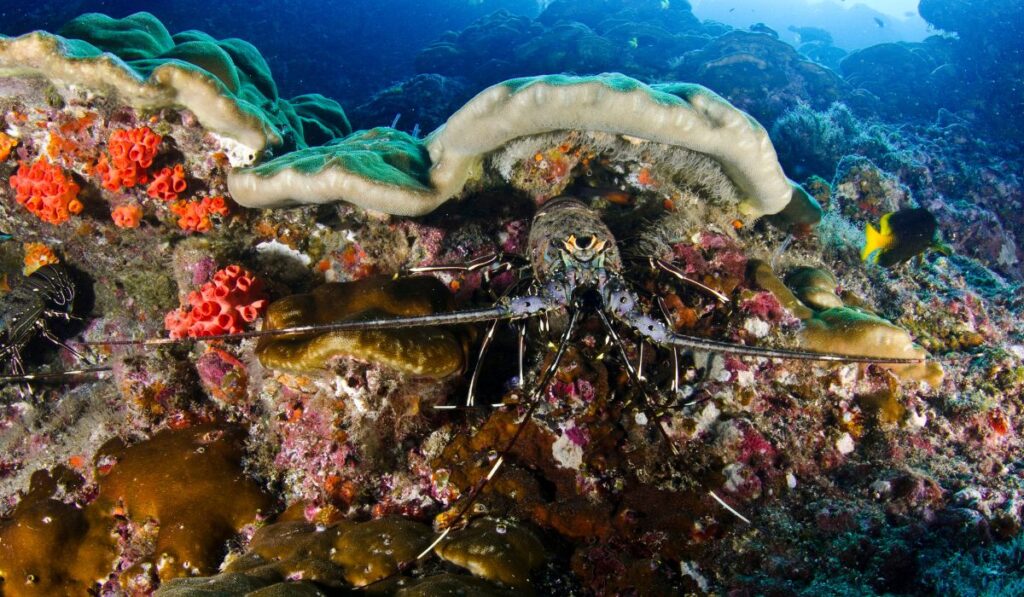
The dry season (mid-December until end of April) is the best time to visit for good weather and clear visibility. There will be almost no rain during this time of year.
This is the best time to visit if you have a tendency to get seasick because the waters will be much calmer.
The rainy season (May until mid-December) means almost daily rain storms usually in the afternoon. During this time of year, the water may be much rougher. However, this is the best time to see hammerhead sharks and manta rays.
If possible, we suggest visiting in mid-July. Usually, Costa Rica experiences a mini summer during this time of year and the rain stops for about two weeks. This also happens to be when hammerhead sharks are about at their peak.
Diving Conditions
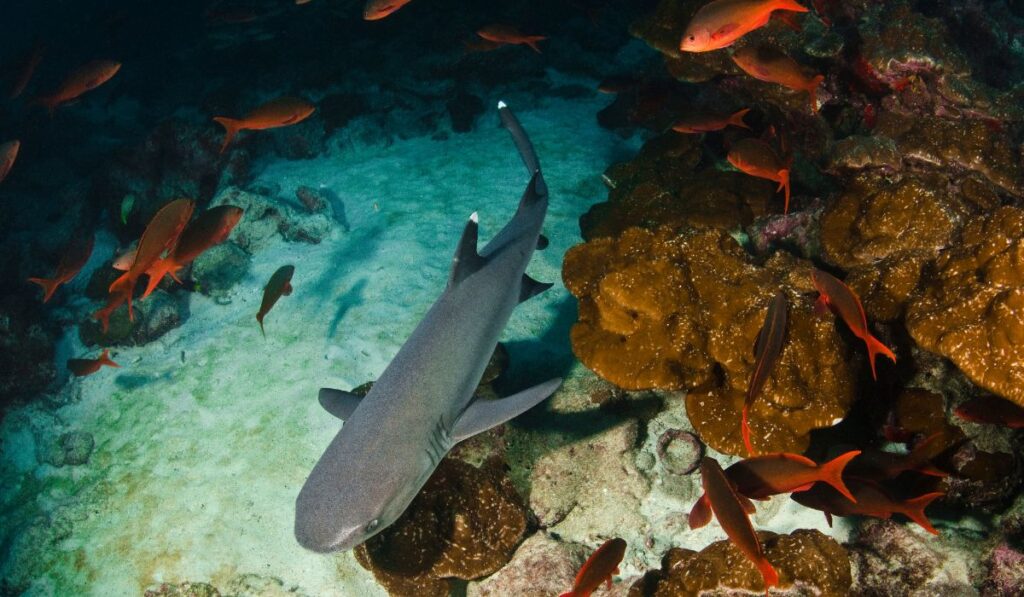
Most of the diving sites are open water. Keep in mind that many of the diving sites are located on submerged mountains and can have strong currents depending on the time of year.
The water temperature is usually between 75 and 85 degrees Fahrenheit.
The visibility is generally between 30 and 100 feet. Most dives are between 30 – 131 feet (10 – 40m).
For this reason, Nitrox diving is recommended.
What to Pack for the Liveaboard Experience
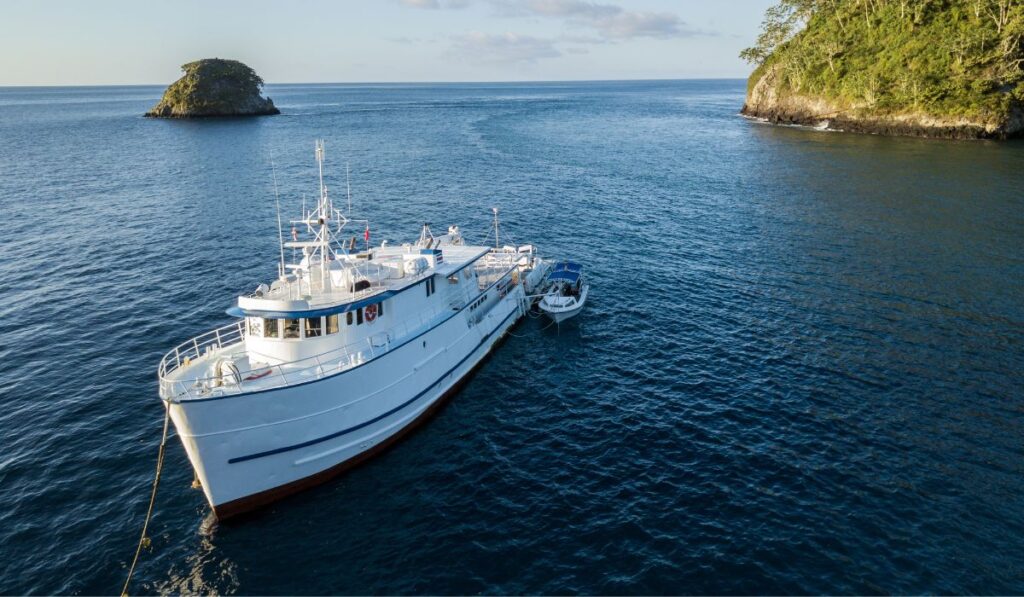
It is recommended that scuba divers bring:
- Bug spray
- Reef-safe sunblock
- Comfortable clothes for while on the boat
- BCD
- Dive computer
- dive light
- fins
- mask
- regulator
- snorkel gear
- wetsuit (between 3 and 5mm)
- dive watch
- dive gloves
- dive knife
- depth gauge
Tanks, weights, and weight belts will be provided on the boat.
We suggest that you put all of your gear in luggage designed for diving gear. This will help keep everything secure and well packaged.
If needed, it is always possible to rent all equipment on the boat for the extent of your diving adventure. This will save you from the hassle of lugging everything with you.
Also, laundry service is available on most boats.
PADI Requirements
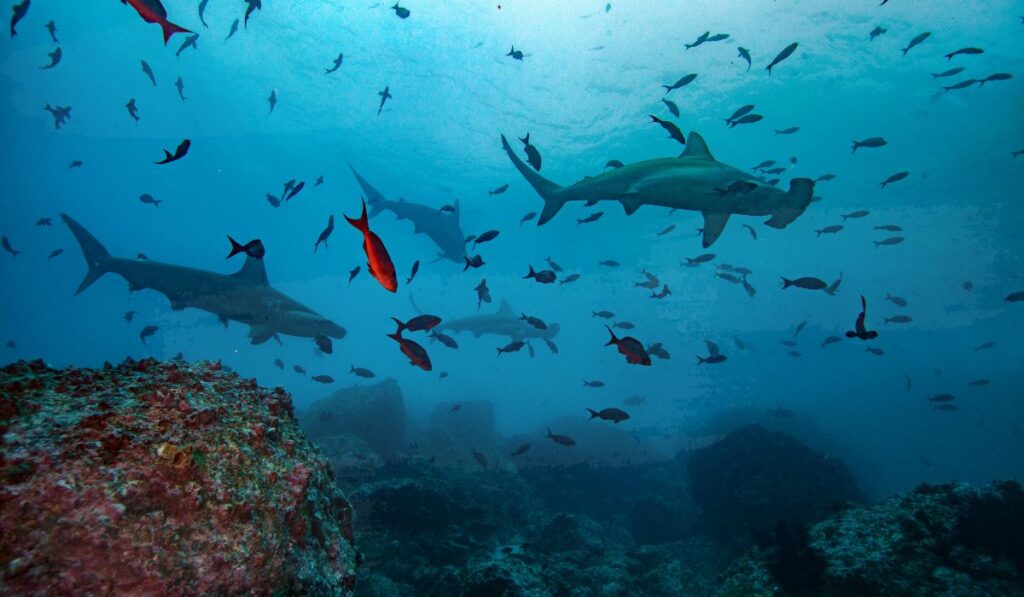
We recommend this trip to more experienced divers. It is a full immersion into diving and if it is not something you are super passionate about, it may be a bit much for you.
However, for most tours, the only requirement is that you have your PADI open water certification.
There is no requirement for the number of dives completed, but 50 hours of completed dive time is highly suggested.
Most tours will offer the Enriched Air Nitrox course for an extra fee.
Safety Notice
All tours and dives are led by certified guides with extensive training. That being said, occasionally things happen.
I say that because a woman from New York was killed here in 2017 during an unprovoked tiger shark attack.
Her diving instructor was also bit in the leg but survived the attack.
Tiger sharks in the area are a relatively new thing and are very rare.
Cocos Tour Options
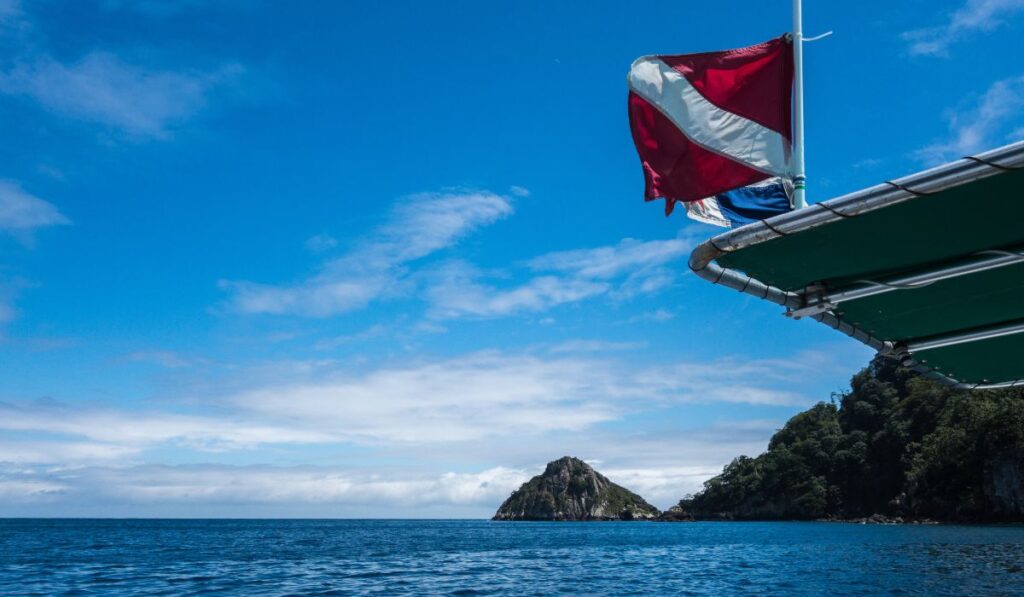
In order to visit Cocos Island it is necessary to take a multi-day liveaboard-style boat trip. This is due to the fact that it is located over 300 nautical miles off of Costa Rica’s coast and the fact that nobody besides park rangers are allowed on the actual island (they are trying to keep all the buried treasure for themselves 😉 ).
The boat trip out to Cocos Island from the Puntarenas port takes between 36 to 48 hours.
All liveaboard boats will anchor it the bay off of the island at night. Staying on the island is not permitted.
There are multiple tour options. Here are the best options.
MV Sea Hunter
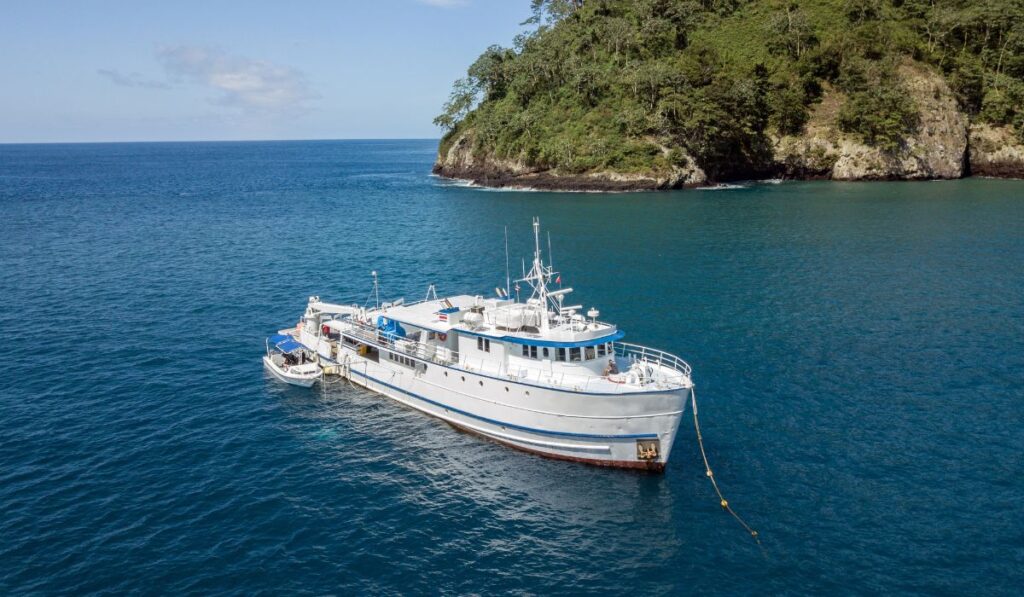
⭐️ RATING: 9.3 on LiveAboard | ⏳ TOUR LENGTH: 10 to 11 days | ✅ Book it!
Amenities
This boat has 10 cabins which accommodates 20 guests in twin and double bed air-conditioned suites. All rooms have en-suite bathrooms. The boat has an air-conditioned restaurant, sundeck, entertainment lounge, and a study with books.
Tour Length
Tours vary between 10 and 11 nights
Tour Schedule
Plan your flight to fly in and out of the San Jose International Airport. You will need to organize your own transportation from the airport to your hotel in San José for the first night.
The next morning, the boat’s crew arranges to pick up only from these 4 hotels: Grano de Oro, Park Inn, Hampton Inn, and Costa Rica Marriott, so you will need to book your stay at one of those places.
A sample itinerary based on the length of your trip is as follows….
Day 1: Meet in front of the host hotel in San Jose. A transfer service to Puntarenas will be provided. Along the way, you will stop for a snack and lunch. You will then board the boat and depart for Cocos Island.
Day 2: It will take approximately 36 hours to arrive at Cocos Island.
Day 2-9: These days will consist of eating, sleeping, and diving around the multiple island diving sites. Meals will be provided throughout the day. Most days consist of three dives, but three times during the trip there will be an option for a night dive as well.
Day 9-10: Travel back to Puntarenas.
Day 11: Check out of the boat at 8am. A transfer bus will take you back to San Jose Airport or host hotels.
Price
In addition to the liveaboard rate you will also need to pay
- National Park Fee – USD 553 (to be paid in advance)
- Fuel surcharge – USD 200 per person (to be paid onboard)
Okeanos Aggressor
⭐️ RATING: 8.4/10 on LiveAboard | ⏳ TOUR LENGTH: 10 nights | ✅ Book it!
This is a brand-new yacht that was built in 2022. It is a beautiful mix of luxury and practicality.
Amenities
- 10 nights accommodation
- 7 days of diving (3-4 dives per day)
- Full board
- Snacks, soft drinks, water, tea, coffee, local beer and wine
- 12l tanks and weights
- Dive guide
- Scheduled group transfer from San Jose to yacht terminal
- Free short-term DAN diving insurance (upon request)
This yacht accommodates 22 guests in 5 deluxe staterooms and 4 master staterooms.
Each room has an individually controlled AC, TV and media player, bathroom, and ample storage space. All meals are served in the dining room.
The food consists of freshly prepared local cuisine, American, and BBQ. There is a large salon with entertainment options as well as a sun deck with lounge chairs, a hot tub and a shaded cocktail deck. All food and drinks are included in the price.
Tour Length
11 days/ 10 nights
Tour Schedule
Plan your flight to fly in and out of the San Jose International Airport.
The organizers of this trip would like you to spend your first and last night at the Park Inn in San Jose if possible. This makes it easy for them to pick you up in the morning.
You can book your stay at the Park Inn here
You will need to arrange your own transportation from the airport to Park Inn. We suggest just getting a registered taxi from the airport.
Day 1: Meet in front of Park Inn. A transfer service to Puntarenas will be provided. This drive takes about 1.5 hours. You will then board the Aggressor and depart for Cocos Island.
Day 2-3: Arrive to Cocos Island and begin diving.
Day 4-8: These days will consist of eating, sleeping, and diving around the multiple island diving sites as well as visits to the island for nature exploration.
Day 9-10: Travel back to Puntarenas.
Day 11: Check out of the boat at 7 am. A transfer bus will take you back to San Jose Airport or Park Inn hotel.
Price
On top of the diving tour price, you will need to pay for any gear that you need to rent, Cocos Island Park Fee to be paid on board (USD 490 per person + 13% VAT), Cocos Island Emergency Evacuation Plan – USD 30 per person (to be paid on board).
Also, flights, hotel on the first and last night, Nitrox, and crew gratuities are not included.
Okeanos Aggressor II
⭐️ RATING: 8.6/10 on LiveAboard | ⏳ TOUR LENGTH: 10 nights | ✅ Book it!
Amenities
This yacht accommodates 22 guests in 11 cabins. All meals are served in the dining room and consist of freshly prepared American style cuisine.
There is a large salon with entertainment options as well as a sun deck with lounge chairs and a bar and grill. All food and drinks are included in the price.
Tour Length
11 days/ 10 nights
Tour Schedule
Plan your flight to fly in and out of the San Jose International Airport.
The organizers of this trip would like you to spend your first and last night at the Park Inn.
You can book your stay at the Park Inn here
You will need to arrange transportation from the airport to Park Inn. We suggest just getting a registered taxi from the airport.
Day 1: Meet in front of the host hotel. A transfer service to Puntarenas will be provided. This drive takes about 1.5 hours. You will then board the Okeanos Aggressor ii and depart for Cocos Island.
Day 2-3: Arrive to Cocos Island and begin diving.
Day 4-8: These days will consist of eating, sleeping, and diving around the multiple island diving sites..
Day 9-10: Travel back to Puntarenas.
Day 11: Check out of the boat at 7 am. A transfer bus will take you back to San Jose Airport or host hotels.
Price
On top of the diving tour price, you will need to pay for any gear that you need to rent, Cocos Island Park Fee to be paid on board (USD 490 per person + 13% VAT), Cocos Island Emergency Evacuation Plan – USD 30 per person (to be paid on board).
Also, flights, hotel on the first and last night, Nitrox, and crew gratuities are not included.
Things You Should Know Before Booking
Here are all of our helpful travel tips that your should know before booking your liveaboard adventure to Cocos Island.
There are Multiple Places Called Cocos Island
Don’t get confused when booking your trip. There is also a series of islands in the Indian Ocean called Cocos Islands.
These islands are part of Australia and are sometimes also referred to as “Cocos (Keeling) Islands” or Cocos Islands Malay.
Don’t Forget Travel Insurance
Make sure to purchase a travel insurance plan which will cover you for accidents related to diving.
Conservation Efforts
Conservation of this area is very important. Please be careful not to destroy or take any part of the natural habitat. Leave to trace of your visit except your amazing memories.
Conclusion: Scuba Diving Cocos Island
In conclusion, Cicos Island is a beautiful place with a diverse marine ecosystem. A scuba diving adventure here is bound to be an extremely memorable experience.
So, what do you think? Is a diving trip to Cocos Island in your future? If you have any questions, feel free to comment below. We are always happy to help you out!
You Might Also Like:
Costa Rica Travel Details: What You Need to Know
🚗 Should I rent a car in Costa Rica?
Having a rental car will give you the most flexibility when traveling in Costa Rica. This will also allow you to take fun day trips on your own.
- Save 10% Plus Other Perks with Our Adobe Rental Car Discount
- You might also consider; shared shuttle services or private transfer services
🏄🏽 How can I book things to do?
We find that Viator tends to have the most comprehensive selection of activities with secure booking and good cancellation policies.
🍍 I’m overwhelmed with planning. Can you help?
Of course! I suggest joining our Facebook group for specific questions and head to our Start Here Page to get started planning.
✈️ What is the best way to book a flight?
Usually, we have the best luck finding great prices with Skyscanner. Check for flights to both San Jose Airport (SJO) and Liberia Airport (LIR).
🛏️ What is the best way to book my Costa Rica hotels?
We highly suggest Booking.com for hotel bookings and typically use VRBO for Costa Rica vacation rentals.
🗣️What is the main language in Costa Rica?
The main language in Costa Rica is Spanish. Most people working in tourism speak at least some English.
💰 What is the currency in Costa Rica?
The currency used in Costa Rica is the Costa Rican colón (CRC). However, the US dollar is widely accepted in most tourist areas
📞 What is the best way to stay connected?
An eSIM from Airalo is the easiest way to get 4G data while traveling in Costa Rica.
🌴 Is Costa Rica safe?
Generally, Costa Rica is considered safe for tourists. However, like any travel destination, it’s best to use caution and be aware of your surroundings.
🛂 Do you need a passport to go to Costa Rica?
Yes, Costa Rica is its own country. You will need a passport to visit.

Hi! We’re Thomas (the German) and Sarah (the US-er)
We met in Virginia, moved to Germany, and since 2016 we have lived in sunny Costa Rica.
It was a spontaneous decision to move here, but it was the best decision!
Now we spend our days roaming the country to bring you the very best in Costa Rica travel here on Costa Rica Vibes.
Sarah is the writer. Thomas is the one keeping it all together.
Want the whole crazy story?

Sarah McArthur
Sarah McArthur is the co-founder and main writer of Costa Rica Vibes.
She is originally from the United States but has lived in sunny San Jose, Costa Rica since 2016.
She has traveled all over the country and now considers herself a self-proclaimed Costa Rica travel expert.
Want the whole crazy story?

